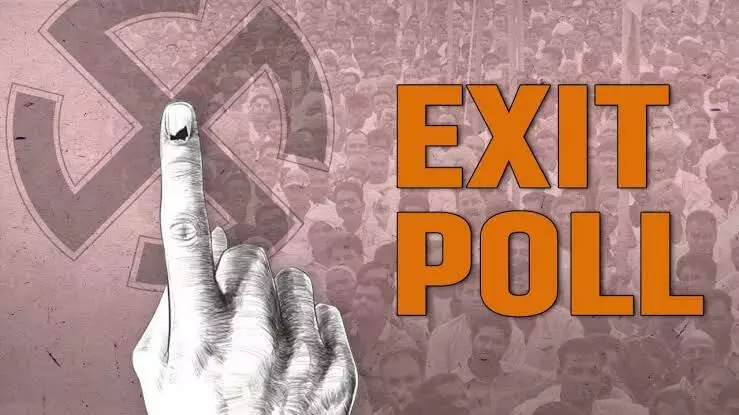The Illusion of Certainty: How Unreliable Exit Polls Erode Public Trust in Indian Democracy

As Delhi waits for its election results, a weary electorate sighs at exit poll predictions yet again – not in surprise, but in resigned recognition of a broken system. The existing pattern of miscalculation is no anomaly; it’s symptomatic of a deeper crisis in India’s electoral discourse. Exit polls, once hailed as democratic crystal balls, now increasingly resemble speculative fiction, undermining public trust at every miscalculation. From the 2024 Lok Sabha shocker that wiped ₹14 lakh crore off stock markets to persistent state-level misses, the credibility gap has become a chasm.
India’s tryst with unreliable exit polls began in earnest during the 2004 “India Shining” debacle when every major pollster predicted a BJP victory, only to be humbled by a Congress-led upset. Two decades later, the 2024 general elections repeated history on steroids: pollsters’ average projection of 350+ seats for the NDA collided with the reality of 293 seats, exposing methodological rot.
State elections tell the same story. The 2020 Delhi polls saw agencies split between predicting AAP’s victory (C-Voter: 48-60 seats) and a hung assembly (Today’s Chanakya: 37-47), while AAP secured 62 seats. In Chhattisgarh’s 2023 elections, Axis My India’s 54-64 seat prediction for Congress shriveled to 35 actual seats. These aren’t mere misses – they’re systemic failures that distort political narratives.
Three structural flaws plague Indian exit polls:
1.Demographic Blind Spots: Most agencies sample 25,000-50,000 voters nationally – statistically inadequate for a 970-million electorate. Urban bias persists, as seen in 2024 when Mumbai-centric surveys missed rural Maharashtra’s anti-BJP shift.
2.The “Modi Effect” Mirage: Pollsters over-index on leadership popularity, ignoring local factors. The 2024 Karnataka polls saw BJP projected to win 12-14 seats based on Modi’s rallies; they secured 6.
3.Voter Deception: Social desirability bias peaked in Uttar Pradesh (2019), where 23% of Jatav voters lied to surveyors about supporting BJP, according to CSDS data.
The consequences are multidimensional. In 2024, reliance on flawed polls saw BJP over-prepare for West Bengal (projected 25 seats, won 12) while under-resourcing Odisha (projected 8, won 15). Political strategists privately admit campaigns are now planned assuming 15% polling error margins.
When the Election Commission’s 6:30 PM exit poll ban during Delhi’s 2025 polls forced social media users to rely on speculative reporting, Twitter trends showed #FakeExitPolls circulating 12,000 times hourly. This vacuum birthed dangerous alternatives:
-Shadow Polls: WhatsApp groups peddling unverified “ground reports”
-Algorithmic Astrology: AI models like PolisPredict claiming 89% accuracy through dubious sentiment analysis
-Financial Mayhem: In 2024, YES Bank shares rose 18% pre-results on exit poll-driven optimism, then crashed 26% post-results
The human cost is subtler but profound. A 2024 Lokniti-CSDS survey revealed 61% of voters consider exit polls “entertainment, not information” – a dangerous trivialization of democratic tools.
The Election Commission’s ban on exit polls under Section 126A of the RP Act, while well-intentioned, has become counterproductive. By delaying all polls until voting concludes, it:
1.Stifles Course Correction: Parties can’t adjust strategies between phases
2.Encourages Black Markets: A 2025 IIM-A study found 68% of political workers access underground exit polls costing ₹5-10 lakh per report
3.Infantilizes Voters: Assumes citizens can’t process information responsibly
Compare this to France’s model: polls publish immediately after voting ends in each region, maintaining momentum while preventing cross-phase influence.
*Rebuilding Trust – A Five-Point Manifesto*
1.Transparency Mandates:
- Require disclosure of sample sizes, demographics, and confidence intervals
- Publish raw data (as UK’s BBC does) for academic scrutiny
2.Staggered Release:
- Phase-wise polls in multi-stage elections, updated daily
- Real-time dashboards showing methodology adjustments
3.Accountability Framework:
- ECI-maintained accuracy scorecards rating pollsters
- Penalties for consistent underperformers (e.g., Today’s Chanakya’s 43% error rate in 2024)
4.Public Education:
- EC-sponsored tutorials explaining margin of error concepts
- Media literacy programs debunking “seat conversion” pseudoscience
5.Tech Integration:
- Blockchain-verified polling (pioneered by Argentina in 2023)
- AI-assisted sentiment tracking with open-source algorithms
The U.S. National Election Pool’s 15,000-respondent surveys using precinct-level weighting offer methodological rigor. Germany’s Infratest dimap combines exit polls with postal vote analysis for 98% accuracy. India’s solution must hybridize these models with grassroots innovation:
- Deploy mobile survey teams at 1% of randomly selected booths
- Partner with rural SHGs for decentralized data collection
- Use UPI-style verification for remote voter interviews
As India approaches one election after another, the choice is stark: persist with broken models that turn democracy into spectator sport, or reinvent exit polling as a tool of participatory governance. This demands collaboration – regulators ensuring transparency, media prioritizing accuracy over TRPs, and citizens demanding accountability.
The stakes transcend politics. When a daily wage worker invests hope in a poll-predicted welfare scheme that never materializes, or a first-time voter becomes disillusioned by repeated prediction failures, democracy’s fabric frays. Reliable exit polls aren’t about numbers – they’re about restoring faith in the idea that every voice matters, even before it’s counted.
